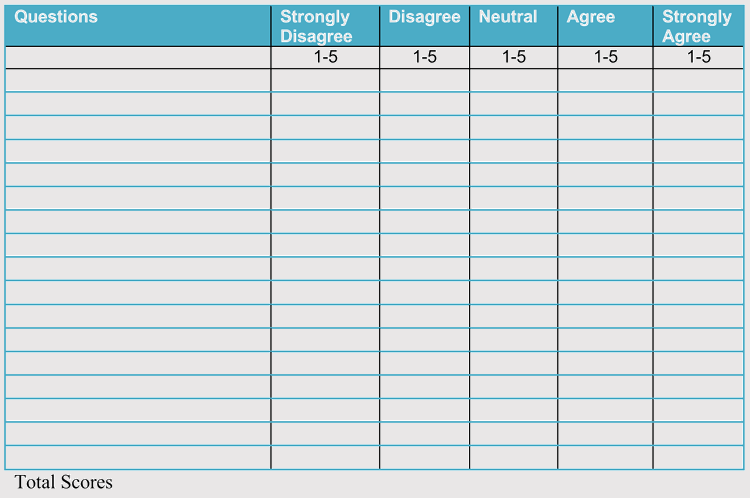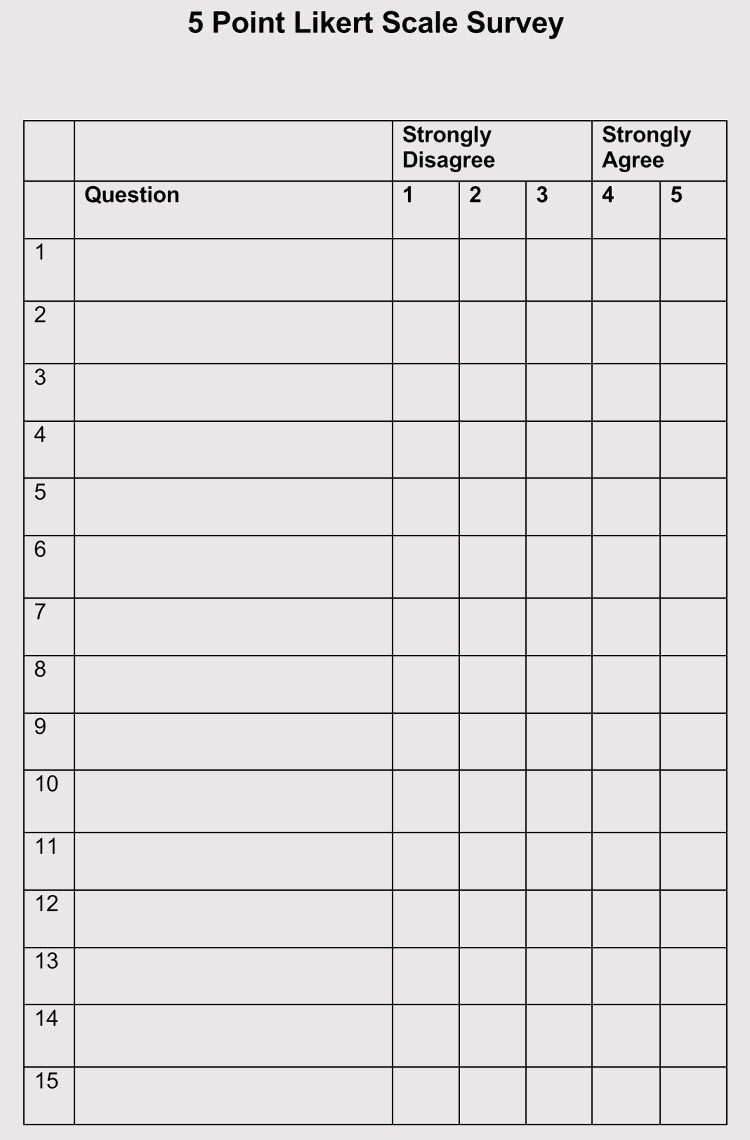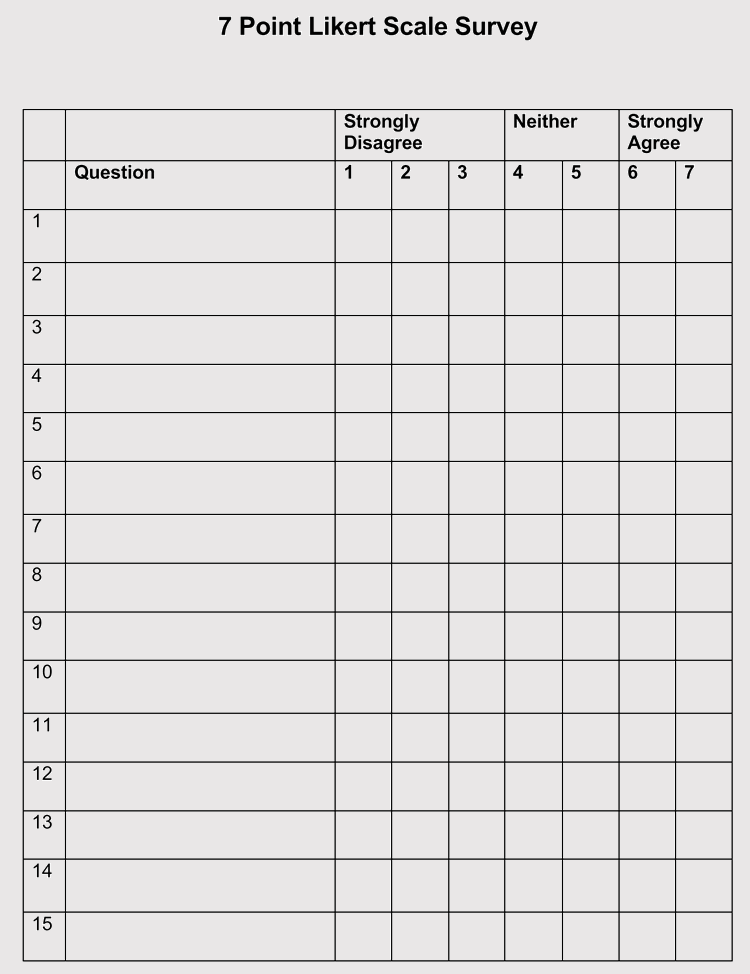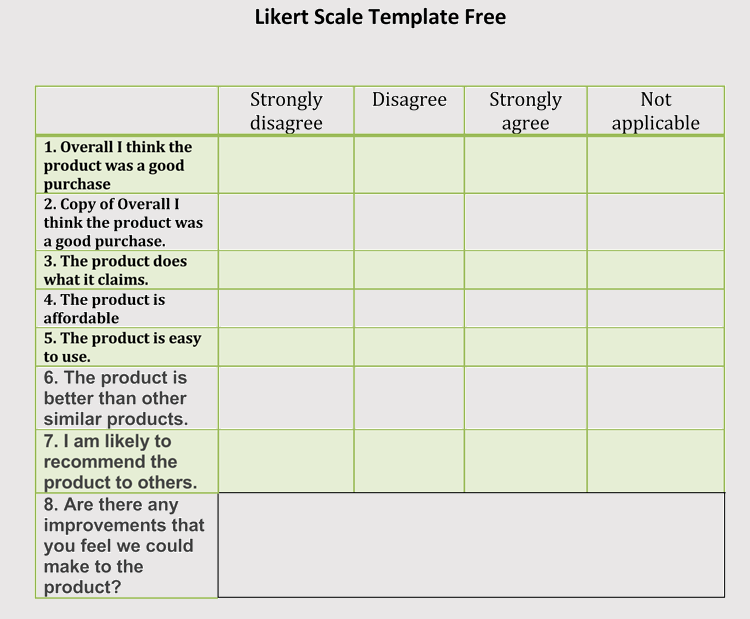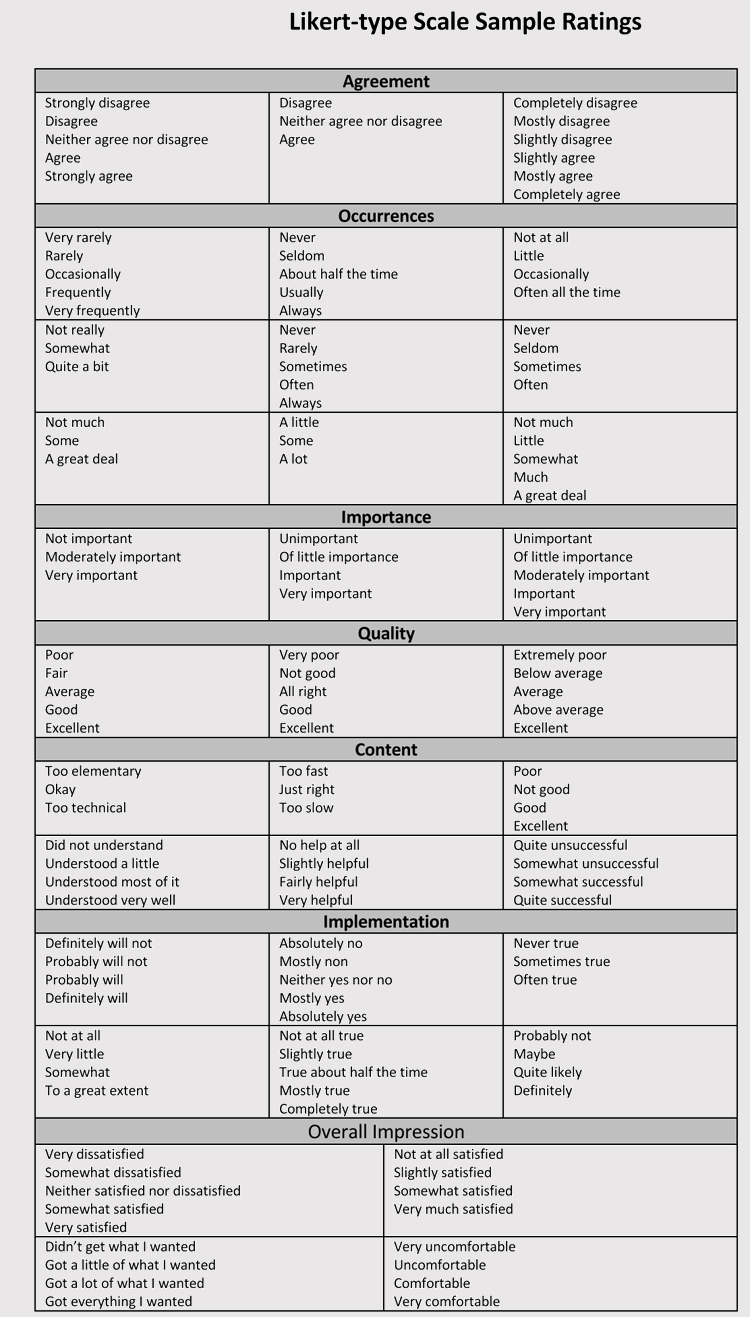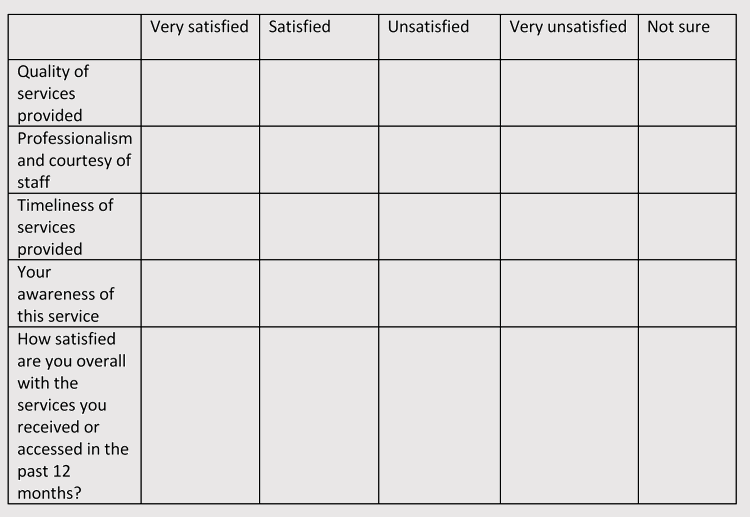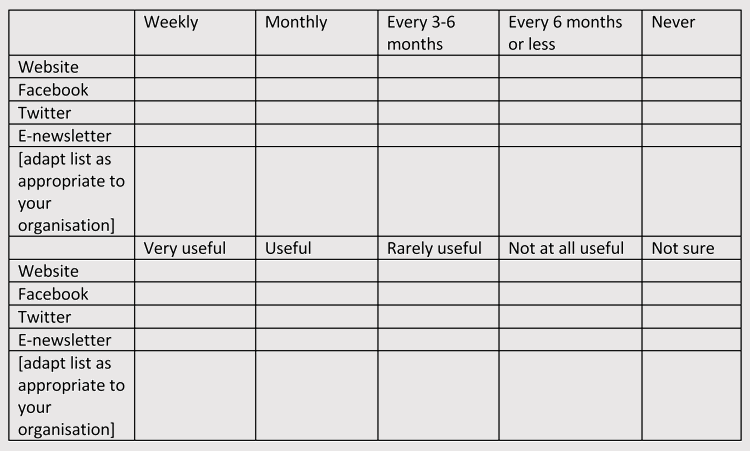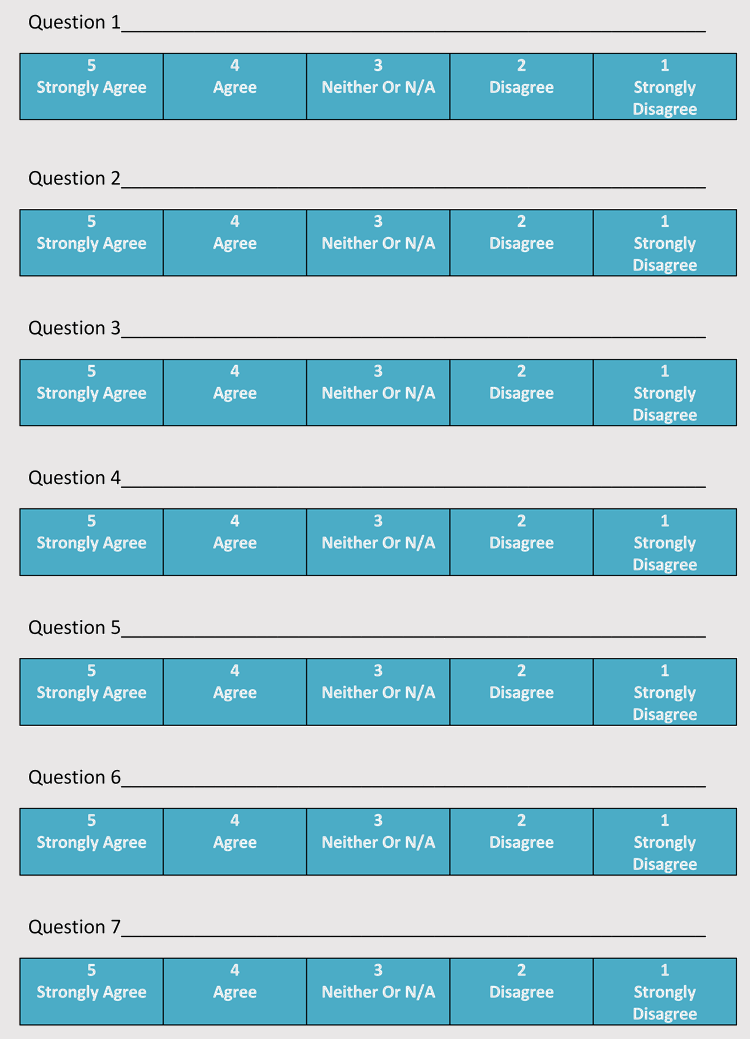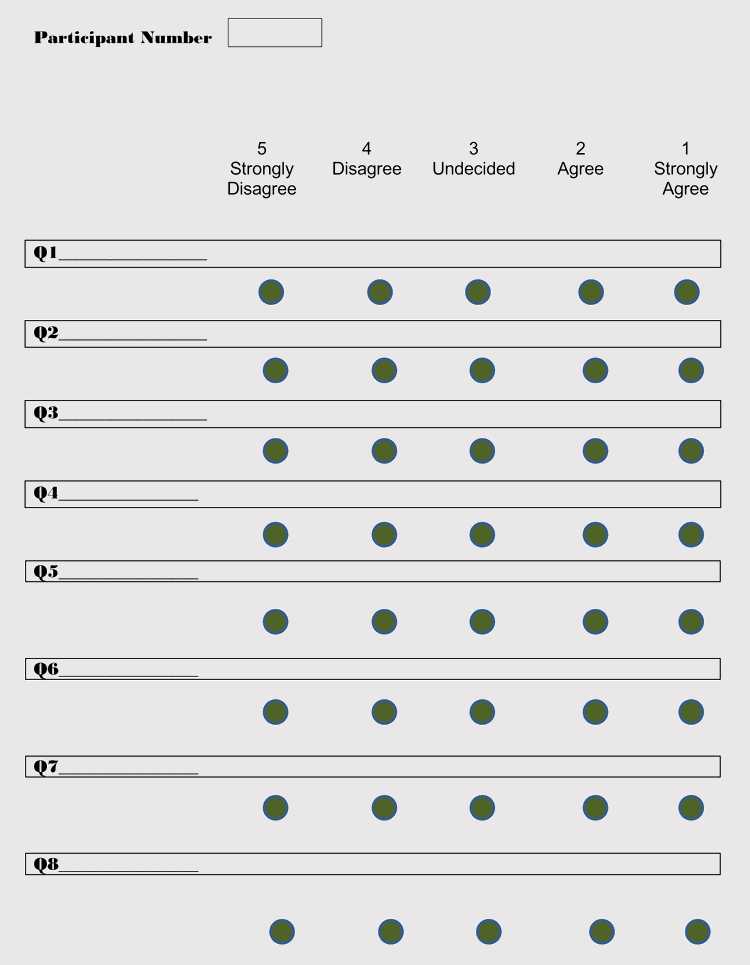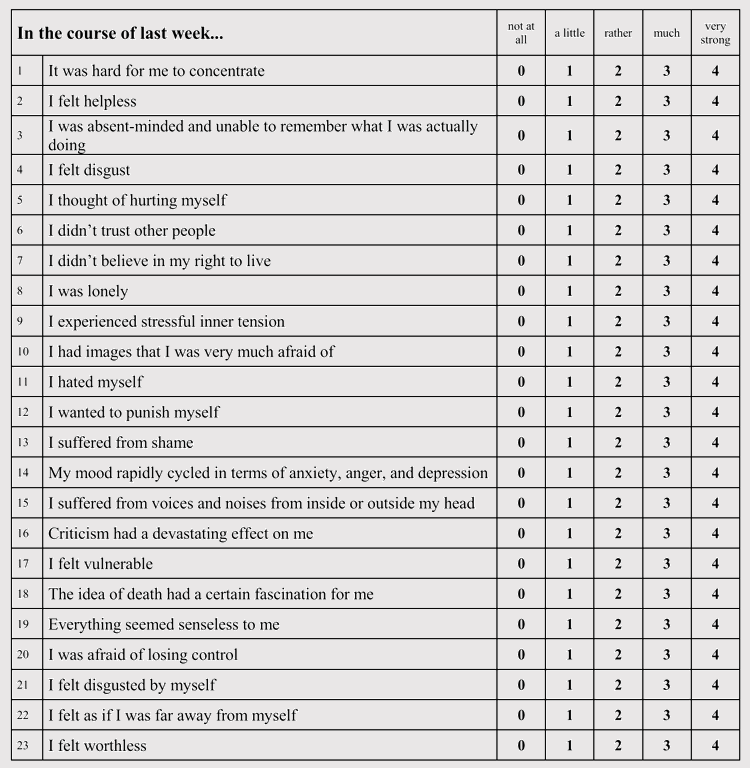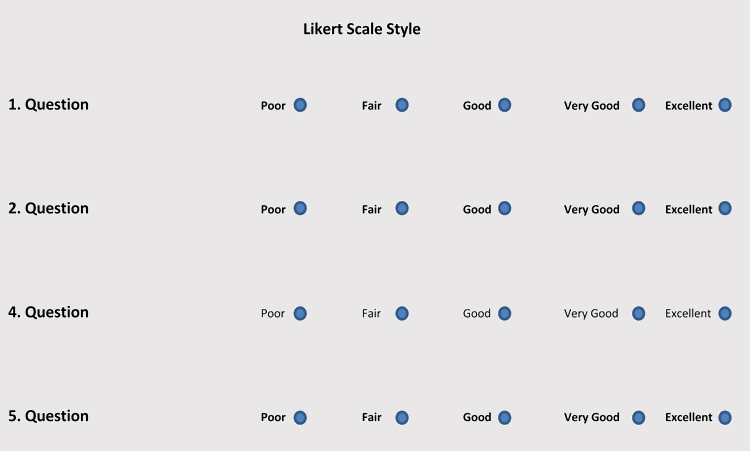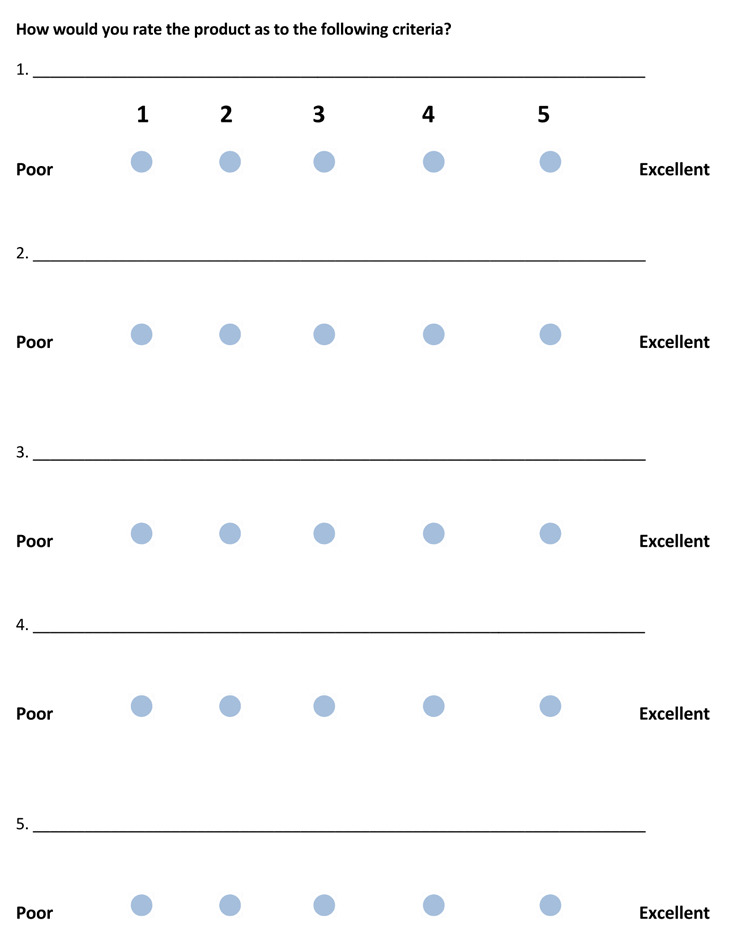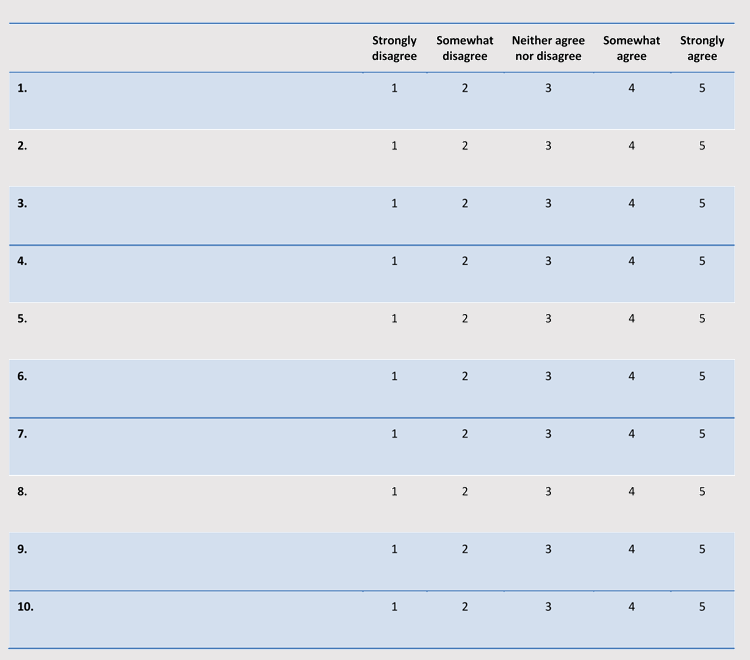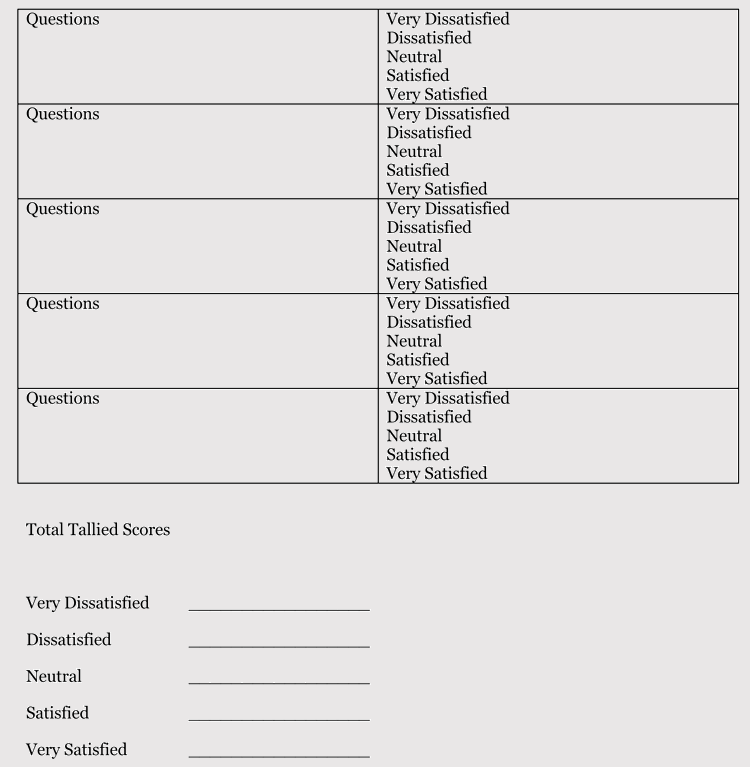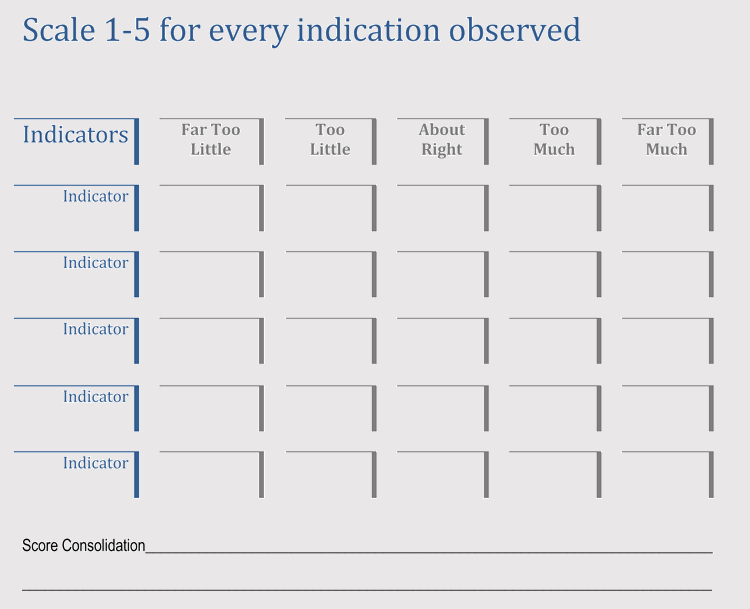A Likert Scale is an asymmetric psychometric or rating scale used in questionnaires allowing respondents to specify their level of agreement or disagreement.
In this article, we have provided a how-to-create guide along with the Likert scale examples. But first, let us understand the purpose of the Likert scale :
Likert scales can thus be used to measure opinions, perceptions, attitudes, and behaviors by providing respondents with a satisfaction scale that rates possible answers to a question or statement from extreme, neutral, to moderate. The Likert scales were created by Rensis Likert, an American social scientist hence the name “Likert” scale.
Likert scale examples are majorly used in educational and social research. The scale will normally have a five or seven-point scale, each point representing a certain degree of opinions such as agreement or disagreement with a question or statement. Likert scales play a huge role in understanding feedback being received. They are also used to identify areas of improvement for a particular service or product.
Likert Scale Example
To understand how it is used, look at the Likert scale example below.
Statement: The G7 is doing enough to curb the negative effects of climate change.
| Strongly Disagree | Disagree | Undecided | Agree | Strongly Agree |
|---|---|---|---|---|
| 1 | 2 | 3 | 4 | 5 |
This example assumes the respondent’s opinion can be measured in five ratings. Their level of agreeableness or disagreeableness is assumed to vary linearly from strongly disagree to agree strongly. Other variations used in Likert scale templates are frequency, importance, and quality.
Likert Scale Common Response Anchors
Likert scale questions base opinions, perceptions, and attitudes on different variations. These variations are referred to as Likert scale response anchors.
They include:
- Agreement: Responses based on the level of the agreement are rated from strongly agree to strongly disagree.
- Frequency: Under frequency, the intensity ranges from often/always to never.
- Quality: Quality is measured from very good to very bad.
- Likelihood: Likelihood is rated from definitely to never.
- Importance: The level of importance is measured, ranging from very important to unimportant.
Each alternative/response under the response anchors is assigned depending on the desired outcome. For example, in a survey on the usefulness of a new feature on an app, if the ideal response is strongly agreed upon, it is assigned the highest number on the point scale, say 5 on a five-point scale. Other responses would be rated as follows – agree -4, neutral-3, disagree-2, and strongly disagree-1. It is essential in categorizing responses.
For example, in such a situation as the one mentioned, 4-5 would represent desired outcomes while 1-2 scores would represent the undesirable outcome.
When to Use the Likert Scale
Likert scales are applicable in different types of surveys in different fields. They are, however, most suited for surveys that can be narrowed down to one specific question or statement whose answers will be based on a person’s opinion, perception, behavior, or attitude.
For example, Likert scale templates would be suitable for the following scenarios:
Reaction to a new product
Businesses can use Likert scales to measure customer satisfaction from newly introduced products. Variations that can determine how receptive the customers are include satisfaction, desirability, agreement, frequency, and importance. For example, ask the customers how important or unimportant the added sign-up feature is in simplifying access to our website? The responses can be labeled as not important, important, neutral, slightly important, and very important.
Recent development in office
Likert scale templates are also applicable in workplace environments. Management can use the scales to engage with their employees and obtain feedback for different things within the workplace. For example, how satisfied or unsatisfied are you with the current working schedule? The responses can be rated as very satisfied, somewhat satisfied, neither, somewhat dissatisfied, and very dissatisfied.
Customer service feedback
Customer service is important in maintaining customers. Likert scales can be used by businesses to obtain feedback on how well their services are being offered. The variations that can be used to determine this feedback are satisfaction, quality, etc. Customer feedback can then be analyzed to determine if the service is satisfactory and to what intensity.
Public event success
To determine the success of professional events, marketers use Likert scales to collect valuable feedback from attendees. Different aspects of an event can be measured, such as the overall experience, the probability to attend again, entertainment, location, and value of the event.
Sentiments for a cause
In any situation where people’s sentiments towards something specific such as a cause, occurrence, policy, etc., need to be measured, the Likert scale templates can be used. It is because the scales offer more insight into what people are thinking.
Two Types of Analysis on the Likert Scale
Data obtained from Likert scale surveys need to be analyzed for it to be assigned meaning. The type of analysis will depend on the type of data obtained.
Ordinal scale data
Most Likert scales use ordinal variables, meaning it cannot be ascertained that the difference between each subsequent response and the other is equal. For example, it is impossible to prove that the difference between strongly disagreeing and disagreeing is not the same as the difference between neutral and agree. As a result, the mean cannot be found for ordinal data.
Statistics choices
Therefore, statistical methods used to analyze Likert scale data are mode, median, range, and interquartile range, and bar charts/frequency tables.
These statistical techniques are used as shown below:
- Mode: The mode is used to determine the most common response among respondents.
- Median: The median is used to find the “middle” or “neutral” response when all responses are assumed to exist as a continuum – from extreme to moderate.
- Range and interquartile range:The range is used to illustrate the variability of responses and categorize different variations into groups (quartile) that mean more or less the same.
- Bar charts: Bar charts/frequency tables are used to show a table of results/responses by illustrating how many times (frequency) each response was given.
Hypothesis testing
Hypothesis testing is another technique used in analyzing Likert scale questions. Hypothesis testing uses an independent variable and a dependent variable. In the Likert scale, the independent variable is the groups of respondents, while the dependent variable is the opinion, perception, or response being measured. For example, in a survey that seeks to determine how satisfied a group of students are with their teachers, the independent variable is the group of students. In contrast, the dependent variable is the level of satisfaction.
Thus, two types of tests can be done to analyze Likert scale data under hypothesis testing:
- Kruskal Wallis:– A test used to determine whether the median for two groups (independent variables) is different.
- Mann Whitney U Test: A test employed to ascertain if the medians of two groups (independent variables) are different. Mann Whitney U Test is suited for analyzing single Likert scale questions. However, it is prone to different forms of bias such as central tendency bias, social desirability bias, and acquiescence bias. In addition, validity is difficult to ascertain with the Mann-Whitney U Test.
If the responses are categorized into two groups, such as satisfied and dissatisfied, more test options for analysis are feasible with Likert scale templates.
Examples of such tests are;
- Chi-Square: Chi-Square test is used for multinomial experiments where the results from the analysis are counts placed into categories.
- McNemar Test: The McNemar test is used to evaluate if the responses to categories are the same for two conditions/groups of respondents.
- Cochran’s Q Test: The Q Test is an extension of the McNemar test. It is used to analyze if the responses to categories are similar for three or more conditions/groups of respondents.
- Friedman Test: The Friedman test is used to spot the differences in treatment across different attempts.
Measure of association
The measure of association is another technique used to analyze Likert scale data. The measure of association is used to determine if one group of respondents has a different (higher or lower) response from another group of respondents in regard to a particular Likert scale question or statement.
Two approaches are used in a measure of association:
- Ordinal groups: If the groups are ordinal – ordered – such as age groups, the following methods can be used to analyze the data – Kendall’s tau coefficient (variants of tau) such as gamma coefficient and Somers’ D and Spearman rank correlation.
- Non-ordinal groups: If the groups are not ordinal, use Phi coefficient, contingency coefficient, and Cramer’s V.
Interval scale data
Likert scales also use interval scale data – data whose difference (interval) between responses can be determined and is equal. This data can be analyzed using statistical methods and hypothesis testing.
Statistics choice
Statistical methods used to analyze interval Likert scale data include:
- Mean: The mean (average) response can be ascertained from multiple responses. The mean represents the majority’s opinion/response to particular Likert scale questions or statement.
- Standard Deviation
Hypothesis testing
The different hypothesis tests that can be used to evaluate interval Likert scale data are:
- T-test
- Anova
- Regression analysis: Multinomial or ordered logistic regression can be used. In addition, a binary logistic regression can be used if the dependent variables can be combined in two categorical responses, say important and unimportant.
General Information About the Likert Scale
The following are different aspects of Likert scale questions researchers should be aware of:
Categories of response
Likert scale questions categorize probable responses to a question or statement. Statements are used to determine the extent of agreement or disagreement of the respondent. Questions present the respondent with the flexibility to select different levels of responses. Categories used in Likert scales are mutually exclusive – meaning if a respondent chooses one response, it implies they do not think it is any of the other responses.
A neutral category, such as” don’t know” or “neutral,” is included to award respondents who do not feel they are indecisive or inadequately prepared or placed to have an opinion on the subject matter an opportunity to give a response.
Size of likert scale
The size of the Likert scale will vary depending on the topic and probable responses to a question or statement. The smallest size is a five-point scale, and the largest is a seven-point scale. 5-point scales are more commonly used as with 7-point scales (which offer more choices), people tend not to select the extreme categories aiming not to sound too extreme in their view. Categories on large scales tend to be marginally different, eliminating room for respondents to be precise and discriminatory with their responses.
Too small rating scales say 3-point scales such as good, satisfactory, poor, do not offer respondents enough room for sufficient discrimination. Even number Likert scale questions tend to impose a sort of binary opinion – either “for” or “against.”
Directionality of likert scale
Directionality of Likert scale questions means the increasing positive or increasingly negative order in which the categories of responses are presented to the respondent. The direction of a Likert scale implies while each category is different from the other, chronological categories differ in either positivity or negativity depending on the direction – slightly important is more positive than unimportant.
Another aspect used in designing the direction of Likert scale questions is reverse scoring – which stipulates instead of using entirely positive statements, negative statements are also used in the questionnaire. This prompts a respondent with a strongly positive view on the topic to critically evaluate the statement or question, eliminating bias in responses. In reverse scoring, if respondents give positive answers to negative questions or statements, the researcher’s confidence in the data is increased.
Ordinal measures
With the Likert scale questions having directionality, but intervals are undetermined and cannot be assumed to be equal, an ordinal level of measurement is used to analyze Likert scales. Ordinal measurement involves assigning a value (a number) to each category, such as very satisfied=1, satisfied=2, neutral=3, dissatisfied=4, and strongly dissatisfied.
For example, by the directionality of the Likert scale, a score of 4 is more favorable than 5 but more negative than 3, 2, or 1. However, a score of 4 cannot be presumed to be twice as negative as a score of 2.
Descriptive and inferential statistics
There are no orthodox descriptive and inferential statistics used to analyze and describe Likert-derived data. More often than not, Likert-derived data is taken as ordinal data. Hence, the use of median and mode as a measure of central tendency in its analysis and nonparametric tests such as the Mann Whitney U test and Chi-square test. The frequency or percentage frequency of each category of responses can also be determined.
Parametric tests such as ANOVA (analysis of variance) or Pearson’s product-moment correlation are also argued to be feasible with Likert scale questions. This implies Likert-derived data is defined as interval scale data with directionality and equidistant intervals. If Likert-derived data is to be analyzed as interval scale data, this assumption has to be stated, and the data must be manipulated through multiplication and addition. Additional parametric tests include mean and standard deviation.
Careful considerations have to be taken into account before using descriptive and inferential statistics because numerical values represent verbal statements, not amounts or measurements, which makes the manipulation (addition and multiplication) of Likert-derived data questionable. Additionally, such data fails to meet other assumptions used in parametric tests such as normal distribution; researchers must therefore explicitly define their assumptions.
What are Likert Scale Sheet Templates?
A Likert scale sheet template is a fillable blank document containing all the sections that should appear on a Likert scale. In addition, Likert scale sheet templates contain graphical representations of the Likert scale where the user inputs the necessary information accordingly. Thus, templates streamline the process of creating Likert scale sheets. With that in mind, we have provided professionally Likert scale sheet templates for our readers. The templates are free for download from our website.
Following are some free downloadable templates for you:
How to Create a Likert Scale Template in Microsoft?
Researchers can create their own Likert scale templates with different software and platforms. One tool that can be used in this regard is MS Word.
This article will provide a step-by-step guide in creating Likert scale templates in Word:
Insert a 6×6 table
Open MS Word and navigate to the “Insert” tab and insert a 6 by 6 table – six rows and six columns. It is meant to be a five-point scale Likert scale template.
Label the answer choices in the top row
Afterward, label the rows and columns by indicating the Likert scale template items. The categories of the responses should be placed from the second column up to the fifth column.
Order the responses as indicated below:
- Strongly disagree – In the first column. It is the first optional response.
- Disagree – In the second column. This is the second response respondents can choose.
- Neither agree or disagree – In the third column. This represents the third response respondents can choose from. It is the midpoint or neutral option.
- Agree – In the fourth column.
- Strongly agree – In the fifth column
Centralize the text
The next step in creating the Likert scale template is to centralize the text. Select all the columns from the second column and move the cursor to the “Layout” tab and where there are multiple boxes in the toolbar, select the central box to center the row.
Label answer choices from 1 to 5 in each row
Once all the response columns have been centralized, move to the second column and second row, indicate it as “1”, and label each answer choice progressively up to “5”. This is referred to as rating the Likert scale template items.
- Font size – Ensure to use the same font size as the one used in the response categories.
- Font style – Use the same font used in writing the responses in the above row. Consistent font size and style are essential in creating a professional Likert scale template.
Include assessment statements in the first column
Next, enter the statements or questions to be evaluated in the survey. Each statement should occupy its own row and align them to the left. Once all the information of the Likert scale template has been provided, adjust the width and height of the rows and columns such that the numbers are equidistant from each other. Ideally, there should be 3/8 inches between the numbers and text. Next, select the text and numbers, move to the “Layout” tab and adjust the height and width accordingly.
Remove all borders
Lastly, remove all the borders of the table. Next, select the entire table and go to the “Design” tab and go to the “borders” command scroll to the “No borders” option. Once this is completed, the usable Likert scale template has been finalized.
Maximize the Effective Usage of Likert Scale Template
The benefits obtained from using Likert scale templates will be highly dependent on how well the scale was created and executed.
To maximize the benefits of using Likert scale templates, implement the following tips:
Keep it labeled
Label each category of responses and assign the appropriate numerical value. Scales that only use numerical values are difficult to understand as the directionality of the scale would not be clear.
Keep it odd
Use odd-numbered scales. Odd-numbered scales will have a midpoint, thus awarding respondents a neutrality option in their responses. For example, five-point scales are recommended for unipolar scales, while seven-point scales are recommended for bipolar scales. Offering options greater than seven may make it difficult for respondents to settle on an answer and end selecting random options, which compromises the objective of the entire survey.
Keep it continuous
Categories should be equally spaced on a Likert scale template. While this may be difficult when using word labels, it is a conventional design specification. Therefore, ensure the word labels mean exactly what is intended when shortening them to fit the spacing specification.
Keep it inclusive
The scale should be as inclusive as possible. This means the responses must be considerate of all probable opinions to a particular question or statement. Basically, the categories should not be biased to a single direction of perception. For example, a scale that ranges responses from extremely quick to moderately quick is not inclusive as it denies respondents whose opinion is a slow opportunity to give their view.
Keep it logical
The Likert scale template should be logical. Give the respondents an option to skip to the question or statement whose response is more prioritized. This saves the respondents’ time.
Keep the questions focused on one topic
The questions or statements in a survey should be focused on a single topic such that their responses contribute to the overall objective of the research. Objective questions or statements produce more accurate and objective results that are easy to analyze. The questions or statements can also be designed to complement each other such that the response to one question is interrelated with the subsequent question.
Be accurate and keep the focus
The questions posed in a Likert survey should be specific and accurately phrased. The respondent should be able to decipher what exactly they are being asked. For example, when asking if the employees agree with a policy at work, specify which policy – dressing, attendance, benefits, or pension. Accurate and focused questions produce more relevant responses.
Be careful with adjectives
When categorizing responses, the adjectives used should be easily comprehensible. Likewise, the respondents should be able to understand the intensity or extent of the particular category of response. It is recommended that when adding descriptive words to responses, researchers should start from the extremes – for example, very, never to midpoints moderately, neutral and neither-nor and very, often, etc.
Classify as polar or bipolar
The scale should be clarified to be either polar or bipolar. Bipolar responses represent two opposite opinions, such as “love vs. hate,” while polar or unipolar responses represent two extremes of a similar point of view, such as “extremely love to no love.” Unipolar scales are more prevalent and easy for respondents to think about.
Better to ask
With the Likert scale templates, it is better to ask a question than pose a statement. With statements, respondents tend to either agree or disagree, a phenomenon known as acquiescence response bias. Questions, on the other hand, expand their option to choose based on their point of view.
Strengths and Limitations of Likert Scale
Like most survey approaches, Likert scales have their strengths and limitations. The following strengths and limitations are worth considering before any researcher chooses the Likert scale in their survey.
Strengths
Likert scales help researchers avoid generic questions and answers in a survey. The questions can be structured to be more focused, making it easier for respondents to contemplate what is being asked. It ensures respondents give well-thought responses, thus increasing the value of the data. The range of responses offered by Likert scales ensures more accurate surveys are conducted, unlike “yes/no” surveys. Respondents are offered different degrees of opinions with “no option at all” included.
Likert scales use simple and direct language, which helps in keeping the respondents happy during the survey.
The use of self-administered questionnaires like Likert scales offers anonymity to respondents, thus reducing the social pressure to answer questions in a particular way.
Limitations
The creation of Likert scales involves careful evaluation of a particular topic which means it might take slightly longer to come up with the right questions. This is limiting in situations where a quick survey has to be conducted, unlike a “yes/no” or “select all” survey.
The validity of Likert-derived data, like any other survey techniques, is compromised by social desirability – the tendency of respondents to answer questions based on what is socially desirable or accepted.
Final Words
Likert scale templates are essential in conducting focused surveys where opinions, attitudes, perceptions, and behavior must be measured. Likert scales can be 5-point scales or 7-point scales as they are observed to produce more valuable results than other point scales. Likert scale templates offer researchers a way to measure opinions and perceptions. Likert-derived data can be ordinal or interval data. The method of analysis used to interpret Likert scales is dependent on the type of data.
Likert scales can be used for educational purposes such as collecting project data or social purposes such as determining customer satisfaction. Regardless of the field in which the Likert scale is used, the execution is fundamentally similar. The use of Likert scale templates is advocated as it simplifies the process and can be time-saving.
